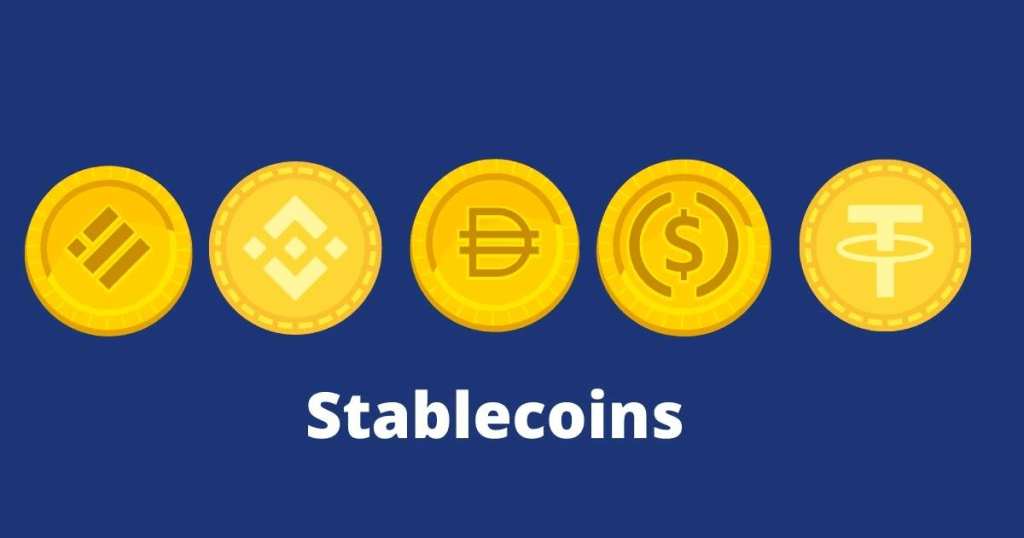UNDERSTANDING THE CRYPTOCURRENCIES DESIGNED TO MAINTAIN A STABLE VALUE; In the volatile world of cryptocurrencies, where prices can experience wild fluctuations, stablecoins have emerged as a unique and sought-after digital asset class. Designed to maintain a stable value, stablecoins provide a reliable and secure alternative for users seeking stability in the crypto market. In this article, we will delve into the fascinating realm of stablecoins, exploring their features, underlying mechanisms, use cases, and the potential they hold in the cryptocurrency ecosystem.

What are Stablecoins?
Stablecoins are a type of cryptocurrency that aim to offer price stability by pegging their value to an external asset, such as fiat currency (e.g., USD, EUR) or commodities (e.g., gold, oil). This pegging mechanism ensures that the value of a stablecoin remains relatively steady, mitigating the volatility associated with other cryptocurrencies like Bitcoin or Ethereum.
Types of Stablecoins
- Fiat-Collateralized Stablecoins: These stablecoins are backed by reserves of fiat currency held in a bank account. Each stablecoin issued is fully collateralized by an equivalent amount of the underlying fiat currency, ensuring stability. Examples include Tether (USDT) and USD Coin (USDC).
- Crypto-Collateralized Stablecoins: These stablecoins are backed by a reserve of other cryptocurrencies. Users deposit a certain amount of cryptocurrencies as collateral, and stablecoins are issued against that collateral. Dai (DAI) is a prominent example of a crypto-collateralized stablecoin.
- Algorithmic Stablecoins: These stablecoins aim to maintain price stability through algorithmic mechanisms and smart contracts. Their supply is adjusted based on market demand and supply conditions. Ampleforth (AMPL) is an example of an algorithmic stablecoin.

Advantages of Stablecoins
- Price Stability: Stablecoins offer a reliable store of value, as their pegged nature helps to mitigate price volatility, making them suitable for various use cases, including commerce and remittances.
- Fast and Efficient Transactions: Stablecoins leverage the benefits of blockchain technology, enabling near-instantaneous transactions with lower fees compared to traditional banking systems.
- Borderless Transactions: Stablecoins facilitate cross-border transactions without the need for intermediaries, making them a convenient option for international remittances.
- Decentralization: Many stablecoins operate on decentralized blockchain platforms, promoting transparency, security, and removing the need for intermediaries.

Use Cases for Stablecoins
- Remittances: Stablecoins can streamline and reduce the costs associated with cross-border remittances by enabling fast and low-cost transactions.
- Trading and Arbitrage: Traders often utilize stablecoins as a means to quickly move funds between exchanges or as a trading pair with other cryptocurrencies to hedge against volatility.
- Decentralized Finance (DeFi): Stablecoins play a pivotal role in the booming DeFi ecosystem, serving as collateral, liquidity, and facilitating various financial services such as lending, borrowing, and yield farming.
- Merchant Payments: Stablecoins provide a stable medium of exchange for merchants, allowing them to accept digital payments without being exposed to cryptocurrency price fluctuations.
Ensuring Stability and Risks
- Collateral Audits: Fiat-collateralized stablecoins should undergo regular audits to ensure that the reserves are properly backed and maintain a 1:1 peg with the underlying asset.
- Counterparty Risk: Users should assess the reputation and credibility of the stablecoin issuer or platform to mitigate counterparty risk.
- Regulatory Challenges: Stablecoins operate within the regulatory frameworks of the jurisdictions in which they operate. Changes in regulations or legal uncertainties can pose challenges for stablecoin projects.
How To Exchange Stablecoins For Fiat on Astro Africa

One of the best cryptocurrency exchanges to emerge from the Nigerian cryptocurrency industry is without a doubt Astro Africa. It is a platform that perfectly exemplifies a platform that is profitable, secure, and transparent. Users of Astro Africa can convert their Bitcoin holdings into Naira or Cedis (with intentions to expand to other regions of Africa). They currently only offer a mobile app that is accessible to Android users. The incredible aspect of Astro Africa is that users have complete control over their portfolios and are not required to keep their assets on the platform in order to trade and withdraw fiat money for free to their local bank accounts. Users are able to concentrate more on trading as a result of not having to worry as much about where their fiat is going to be when they need it. Along with the aforementioned brilliance of Astro Africa, the registration process is among the easiest and most flawless processes ever:
- Go to the Astro Africa sign-up page and enter all the necessary information.
- When the previous step is finished, you’ll immediately get a confirmation number in your email. To complete your signup, simply copy this code.
- When you’re finished, you must create a five-digit transaction pin. You can immediately start trading or exploring the slick user interface because it is so simple.
- For the best possible user experience, make sure you finish off your profile by adding your bank account and other required information.
- Select “Sell Crypto” after that. You first decide how much cryptocurrency, at a minimum of $5, you want to sell. As of right present, you can only exchange Bitcoin (other asset support is already under development).
- The exchange rate, the amount you will be paid in fiat, and the wallet address where you should send your assets are all visible. Your Astro Africa wallet is credited with currency after two block confirmations, and you can then withdraw money to your nearby bank account.
You can always learn more about How To Trade on Astro Africa and read their blog on various posts about how to trade various gift cards and cryptocurrencies effectively. It is an exciting innovation that has come to stay.
UNDERSTANDING THE CRYPTOCURRENCIES DESIGNED TO MAINTAIN A STABLE VALUE

Stablecoins have become an integral part of the cryptocurrency ecosystem, offering a unique solution to the inherent volatility of digital assets. With their ability to provide price stability, fast transactions, and borderless transfers, stablecoins have gained significant traction and found various use cases across industries.
As the demand for stablecoins continues to grow, it is essential for users and investors to understand the different types of stablecoins available and evaluate their underlying mechanisms, collateralization methods, and regulatory compliance. Additionally, ensuring the stability and security of stablecoins is crucial, requiring regular audits, transparency, and trustworthy issuers.
While stablecoins offer numerous benefits, it is important to acknowledge the risks associated with them, such as counterparty risk and regulatory challenges. Users should exercise due diligence and carefully consider the credibility and reputation of stablecoin projects before engaging in transactions or investments.
Stablecoins have revolutionized the cryptocurrency landscape by providing stability and reliability in an otherwise volatile market. Their role in facilitating cross-border transactions, supporting decentralized finance, and serving as a medium of exchange cannot be understated. By understanding the nuances of stablecoins and adopting best practices, users can harness the power of these digital assets to enhance financial inclusion, efficiency, and security in the world of cryptocurrencies.



